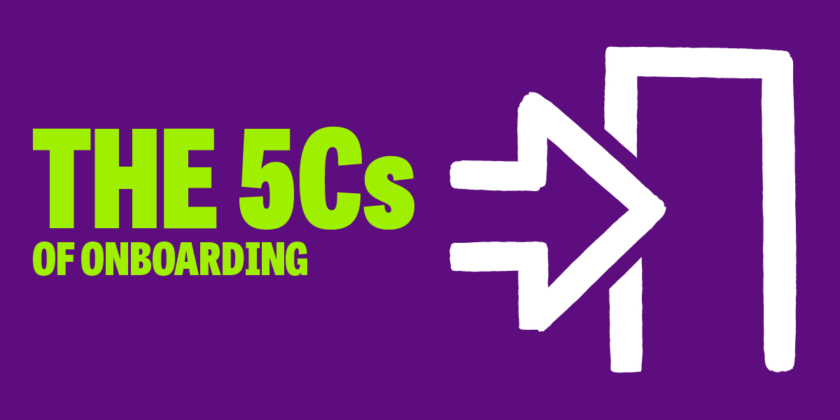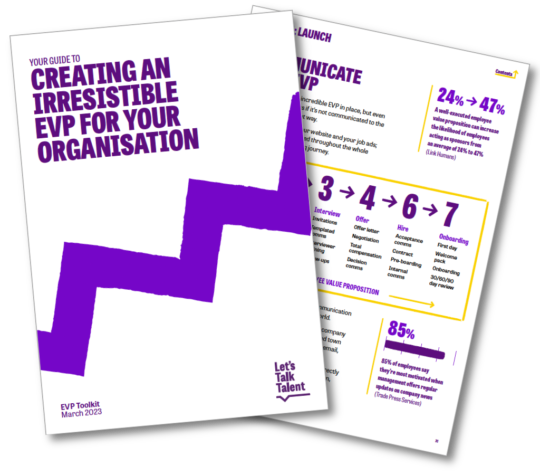Making sure new joiners are thriving from offer through to day 90
We’ve spent a bit of time exploring what an Employee Value Proposition (EVP) is, why it’s important and how to write a compelling one, and even some examples of great EVPs to help get you started. All of which should mean you are now attracting amazing candidates to your business. But once you’ve managed to get great people, how can you craft an incredible onboarding programme to make sure they stay with you?
How can organisations ensure their new employees do not join the 20% of people who decide to leave their brand-new job within the first 45 days?
There’s no denying it: pre-life and early life experiences matter. Feeling like you don’t belong and are left alone in a corner to just figure things out will always be a more powerful feeling than knowing you have great health insurance benefits.
You’ve sold people the dream of working for you; now it’s time to follow through and deliver an amazing first few months of their working life, starting from the moment they receive their offer letter.
Considering that a great onboarding experience can improve retention by as much as 82%, it can have a considerable impact on the effectiveness of your recruitment efforts and budget.
At Let’s Talk Talent, we have a foolproof approach to creating a kickass onboarding programme that works. Only five key elements are required: we call them the 5Cs.
Discover our checklist of the five components needed to shape your onboarding experience into something utterly irresistible.
What makes an effective onboarding programme?
The issue with most onboarding initiatives is a universal one.
Many organisations focus solely on processes and compliance training and, from the day they arrive, new joiners often end up spending weeks in front of a computer screen trying to absorb an inordinate amount of information. It’s no wonder most people dread it.
“Businesses have to appeal to people’s logic, of course, but also to their emotions,” says Jo Taylor, MD at Let’s Talk Talent.
A successful onboarding programme has several objectives, the first of which is to reassure candidates they’ve made the right decision. Then, it should get them excited about things to come. By the end of the process, the basics should have been covered, joiners should feel ready to get stuck in and motivated to be part of something.
“Your onboarding should feel like a warm welcome into a new community, and it should start from the day candidates receive an offer letter,” adds Jo. “So if that’s not the feedback you’re getting, it may be time to review it, bearing the 5 Cs in mind.”
The 5 Cs of successful onboarding
1. Care is the Golden Thread of onboarding
When asking a group of managers what the most important element of a successful onboarding programme is, we’d bet our money on an answer along the lines of ‘understanding how things work’ or ‘getting up to speed quickly’.
For us, it’s care. We all want to work for organisations that care for us. It’s the golden thread that should run through every single element of your employee experience (EE).
It will be the foundation upon which to build the rest of your onboarding approach, and will provide a unique selling point that makes you stand out from most competitors.
Care also means adapting your onboarding to every person that joins the organisation and offering them an experience that will be personalised and unique to their needs.
What does care look like for a new employee? A good manager who takes the time to ensure they are doing well and have everything they need, a good work-life balance, and the kind of working environment where they can perform well and feel like they belong.
2. Compliance: the legal and procedural stuff
This element is about providing recruits with essential information and empowering them to do their job well.
This could include anything, such as teaching them basic legal and policy-related rules and regulations (confidentiality requirements, and even fire safety training), as well as company policies and procedures.
You may think that there isn’t a lot of room for creativity here, but think again!
To make it easy to absorb, consider reviewing the format in which this information is delivered. Could you move from a huge binder of forms to a series of short video tutorials? Or set up a mentoring scheme so colleagues can teach this information, creating opportunities for connections?
3. Clarification of the work they’ll do
This part of the onboarding experience is about making sure employees understand their new role and all the expectations attached to it.
New starters should have a clear picture of where they fit in and what they are expected to accomplish during the first week, month, three-month, or six-month period. “Employees should understand what their first few months will look and, more importantly, feel like,” says Jo.
This part should cover everything from performance management and salary review criteria, to dress code and code of conduct, and everything else that can help them figure out how to get things done in the right way.
4. Culture and putting your purpose forward
Why promote your internal culture during the onboarding stage?
First, it’s important to put your mission forward in order to attract people who match your values and your purpose. But beyond this, your culture will provide employees with a much-needed sense of organisational norms, whether spoken or unspoken.
This gives them a clear idea of the behaviours that are valued within the organisation, and whether they can bring their whole selves to work, safely.
5. Connection and building a network
This component covers the vital relationships and networks new staff have to quickly establish, as well as the resources, support, and guidance they need to be successful in their new role. These will be essential for new recruits to do their jobs effectively, and should be an onboarding priority.
However, the last few years have made it very difficult to foster connections, as more and more tasks are done remotely. Whilst this can be a challenge, it is also an opportunity to be innovative and to try new things.
Rather than putting this component aside throughout the pandemic, creative HR teams everywhere have been setting up buddy systems, virtual events, and online discussion groups.
Make sure you find ways to facilitate the creation of an essential network for your people, so they feel as though they belong within the greater organisational ecosystem.
Successful onboarding programmes focus on the 5 Cs
Onboarding isn’t about giving someone mandatory safety training or filling in reams of paperwork; it’s about giving someone the time to acclimatise to being in your business, giving them the tools they need to get up to speed quickly, and making them feel that they’ve made the right choice by opting to come work with you.
In short, organisations need to manage the expectations of candidates against the reality of working for you, starting before they even come through the door on Day 1. And let’s be honest, spending weeks reading boring official documents isn’t exactly a true representation of reality.
Instead, follow the 5 Cs to create a compelling and effective onboarding programme that talks to your people’s heads and their hearts. But remember that simply creating it isn’t the end of the process.
Don’t forget to regularly measure the effectiveness of your onboarding experience, so you can adapt it along the way. Set up ways to gather feedback from new employees, review churn rate at regular intervals, and use any other data available to continuously optimise your retention efforts. Don’t be among the 55% of business that don’t measure the effectiveness of their onboarding efforts.
And remember, most new employees make a decision about staying or leaving during their probation period, so don’t lose sight of what they need in order to feel excited about what’s coming up. Or, as we like to say, show them that the best is yet to come.
If you’d like some help restructuring your onboarding programme to ensure it focuses on people not process, book a call with us or enquire about our Onboarding Audit. We’re also working on an a new Ultimate Onboarding Checklist, which will be available soon – register your interest to receive it as soon as it’s released.
Related resources:
- Register interest in our upcoming Onboarding Checklist [Free Resource]
- Download our Re-Onboarding Checklist for Managers [Free Resource]
- When Onboarding actually means something positive [Blog]
- Buy our EVP Toolkit to help you get started [Paid Resource]
- Building an Employee Value Proposition (EVP) that attracts and retains top talent [Podcast]
- What makes a good EVP and who does them well? [Podcast]
- 4 ways to write a winning Employee Value Proposition (EVP) [Blog]
- 5 trends in employee value proposition (EVP) for 2023 [Blog]

